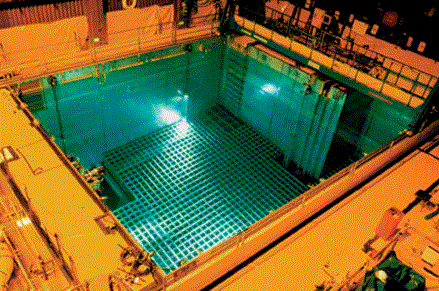I have mentioned before that the spent fuel pools at U.S. nuclear reactors are rapidly filling up and will all be full within five years if none of the spent fuel assemblies are removed. Currently, the spent fuel pools hold about five times as many fuel assemblies as the cores of operating reactors. Unless some of the spent fuel assemblies are removed soon, it will not be possible to refuel reactors and they will need to be shut down.
The U.S. government promised that there would be a permanent geological repository for spent fuel assemblies by 1999. Yucca Mountain in Nevada had been selected for such a repository and much preliminary work had been done when the project was cancelled in 2009. There is no current project to site and build a permanent repository. The best estimates are that there will be no permanent repository until 2050 at the earliest.
Spent fuel pools are especially vulnerable to accidents or terrorist attacks. A recent NRC study that evaluated the possible consequences of a fire at a nuclear power plant in Pennsylvania where spent fuel rods burned concluded that such a fire would lead to forty thousand additional cancer deaths, almost a thousand square miles of evacuated territory and more than four million people being displaced.
There has been a push in the nuclear industry and the U.S. government to move some of the spent fuel assemblies from the spent fuel pool to steel and concrete dry casks on site. The study mentioned above found that if the spent fuel assemblies older than five years in the pools were moved to dry cask, the repercussions of such a fire would be greatly reduced.
Aside from the considerable cost of this alternative, there are problems with the current dry cask designs. Chemical reactions can produce gas in the casks which could lead to explosions and fires. New cask designs are being developed but prototypes will not be available until 2017 at the earliest. So storage is filling up and time is running out to find alternatives.
The Nuclear Regulatory Commission just met and voted on whether or not to mandate on site dry cask storage. The vote was four to one against accelerating the transfer of spent fuel assemblies to dry cask storage. The Commission also voted that “no further generic assessments be pursued related to possible regulatory actions to require the expedited transfer of spent fuel to dry cask storage.”
Given that the spent fuel pools are filling up and there is no permanent geological repository, this would seem to be strange policy vote on the part of the NRC. The reason for the decision was apparently that although such a fire would be catastrophic, the probability of such a fire was very small so no action needed to be taken. Unfortunately, the NRC study did not include the possibility of a terrorist attack. Given that an terrorist attack on a spent fuel pool could be devastating, spent fuel pools would be a prime target for terrorists. In Ukraine, there have already concerns that an escalating military confrontation could lead to deliberate attacks on Ukraine nuclear power plants.
Deliberately disregarding terrorist attacks in consideration of moving spent fuel assemblies to dry casks is a glaring omission in the NRC study and decision. The NRC has not taken important action to insure the safety of U.S. citizens from the disastrous releases of radioactive materials from nuclear power plants.
Spent Fuel Pool:
